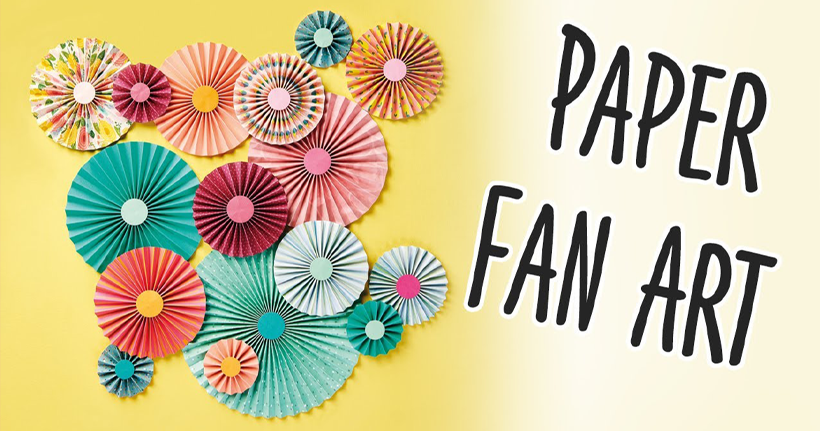_600_338_s_c1.png)
Bored? Here’s 12 Challenging Craft Projects To Keep You Busy
Multiple studies have shown the overwhelmingly positive effect crafting of all kinds can have on your mental health, something you must make sure not to neglect. For those with some...
In issue 137 of PaperCrafter, we were lucky enough to have the chance to speak to John Collins, arguably the greatest paper aeroplane maker the world has ever seen. Read on for a wonderfully varied interview that will give you a peek into John’s mind, motivation, and philosophies – and also a bit of priceless advice for anyone starting out in the paper aeroplane world.
_820_429_s_c1.png)
Do you remember the first paper aeroplane you ever made?
I’m pretty sure the first plane I ever made was the classic dart – the one where you fold the paper in half the long way, fold the corners down and fold over a couple more times to narrow the plane and make wings. I remember being amazed that the plane worked, sort of. It got wobbly after only a couple of throws. Still, being able to create a flying machine by yourself at age eight was pretty thrilling.
What’s your fondest childhood memory?
I have a very vivid memory of the very first plane I invented that rode a thermal gust completely out of sight. I’d had other designs do that, but to have one of my planes fly that well was quite a moment. It was my prototype as well, so there was the exhilaration of watching it fly until it became a speck and then disappear; and then the instant fear that I might not remember how to make another one! The need for documenting my work was suddenly obvious.
A lot of paper artists refer to paper as having ‘an inner life’. What’s special about paper to you?
Wow, what’s not special about paper? It’s all around us every single day, no matter where in the world you go. Origami paper, with its fibers arranged so that there’s no strong direction; copier paper with its ability to handle all manner of ink and travel through printers unscathed; stationery paper made for handwriting; wrapping paper, label paper, phone books, tracing paper, shipping envelopes; it just goes on and on. It’s the ultimate multi-tasking material. What else could be a novel or a flying machine?
Have you ever had a Michelangelo ‘Eureka!’ moment, where the solution to a problem you’ve been gnawing on suddenly presents itself to you?
That actually happened twice with the world record design. When we made the decision to switch to a glider design, I was starting from scratch with a paper size I’d never used to invent a plane. Of course, I’d been thinking about what I’d do while I waited for my first shipment of A4 which is a lot taller, in terms of the proportion of side to width. I liked the idea of noodling around with The Phoenix, a plane from my first book, The Gliding Flight. It turns out, my very first try at folding an A4 sheet was the folding technique I eventually used to break the record. Of course, one has to experiment relentlessly to know that. I tried a lot of variations, and in the end, came back to that folding sequence. It was kind of magical when I realised I’d gotten it right on the very first try.
The other breakthrough moment happened after we switched over to a very smooth paper stock from laid paper (which has ridges). There was a natural change in the angle the wings connected to the body of the plane. This happened from the way the paper was layered. Looking at this, and remembering a practice session where discovered air separated from the wing in different places, depending on the speed the plane was flying, I had a sudden intuition that I could optimize lift to drag by varying this wing connection angle. That turned out to be true (at least experimentally), and I was recently able to verify this idea with some folks I met who happen to work for NASA.

Which inventor(s) or designer(s) has had the greatest impact on you?
In the origami world, John Montroll, Stephen Weiss, and Robert Lang. I own a lot of books from a wide range of amazing origami artists, and I look back on learning the real technical stuff from those three people. On the paper aeroplane side, I was inspired by Klein and Fogleman for their stall resistant wing work. That happened when I was around 10 years old. These guys made the morning news show, which allowed me to dream that important people cared about paper aeroplanes. Ken Blackburn and Takuo Toda are fellow record holders, and I admire their work. Again, there are a lot of fun books out there.
How many abandoned projects are in your plane graveyard?
Hundreds and hundreds. I have boxes and tubs full of paper aeroplanes; designs I’m eventually going to perfect, or ones that I like the base folding. It’s kind of endless. I’ve got a few from when I was ten or 12. Those are kind of raw experimentation, unencumbered and uninformed by any origami technique. They’re interesting to look at now, because they’re so raw. It’s kind of a snapshot of how I thought about folding back then.
What are the cornerstones of paper aeroplane design?
It’s funny that the very thing that convinces most people they can’t make a good paper aeroplane, is actually the bedrock of paper aeroplane design. It’s typical that someone follows the directions for making a plane, and then throws it once. The plane points at the ground and crashes, confirming what our rookie pilot suspected all along, “I can’t make a good plane!” The reality is that all planes are constantly losing speed because of drag, the resistance to forward motion through the air – caused by the surface material and shape of the plane. If you’ve got a powered aircraft, you simply step on gas (or throttle up). With a glider, one needs to engineer in a way for the plane to gain speed lost to drag. We do that by making the front of the plane heavy. Technically, we put the center of gravity in front of the center of lift. That means the tail of the plane gets lifted more, which makes the plane point at the ground. That’s good. The plane is now accelerating toward the ground. Left unchecked, the result is a crash, and, too frequently in the paper aeroplane world, recrimination in the form of, ‘I suck at this’. By making a small upward bend at the back of the plane, when the plane picks up enough speed so that enough air is bouncing off that bend to push the tail back down, we can make the plane gain speed and return to level flight. All gliders work this way, and paper aeroplanes are just another example. It’s funny that the thing the convinces most people they can’t make a good paper aeroplane, is in fact a sign they’ve made a good paper aeroplane; they simply haven’t made the final adjustment. Sharp creases, overall symmetry, careful folding; all of these are important as well. It’s just that I see people read failure into what’s really success, all the time.
You can go back in time and stop one invention from ever being created. Which invention would it be?
It’s so easy to say a nuclear bomb, and I wish we hadn’t ever used one. But the reality is, every invention eventually gets weaponized somehow. Germs, gas, gunpowder, steel, rocks, and bones all have their uses in doing battle. If we ever start thinking seriously about climate change, nuclear power could be a real answer. It’s hardly ever the invention that’s the problem. If we could get rid of malice, hate, and fear; that would be something. As long as those are being taught, it really doesn’t matter what someone invents.
What’s the best thing we humans have ever made?
The scientific method. Without that, we’d still be burning witches and cowering during an eclipse. Right now, self-selection for extinction seems like our trajectory as a species. It’s because we’ve turned away from science at a political level. There’s nothing more catastrophic. There’s nothing more promising than turning back to science.
One person in the world you’d like to spend a day throwing planes with.
Neil deGrasse Tyson seems like he would be pretty fun to hang around with.
What’s next for John Collins?
I’m going to Japan later this year to throw paper aeroplanes. That’s pretty exciting. I’ve never been there. And I’m noodling around with some duration designs. Nobody has ever held the distance record and the duration (time aloft) record at the same time. That would be really cool. It’s all guess work until you get in a big room and let it rip. Everything you thought was right ends up being wrong. It’s one of the things I love about paper aeroplanes and flight. Nobody has it all figured out.
_600_338_s_c1.png)
Multiple studies have shown the overwhelmingly positive effect crafting of all kinds can have on your mental health, something you must make sure not to neglect. For those with some...

*ADVERTORIAL*
Personalisation has been a trend for so long now that we’re done calling it a trend – it’s here to stay. So when we came across Personello, a company that offers a...
_600_338_s_c1.png)
They’re the latest organisational craze – so effective they enabled one journaller to buy their first house. We brushed up on the basics of bullet journalling and put it in a...





